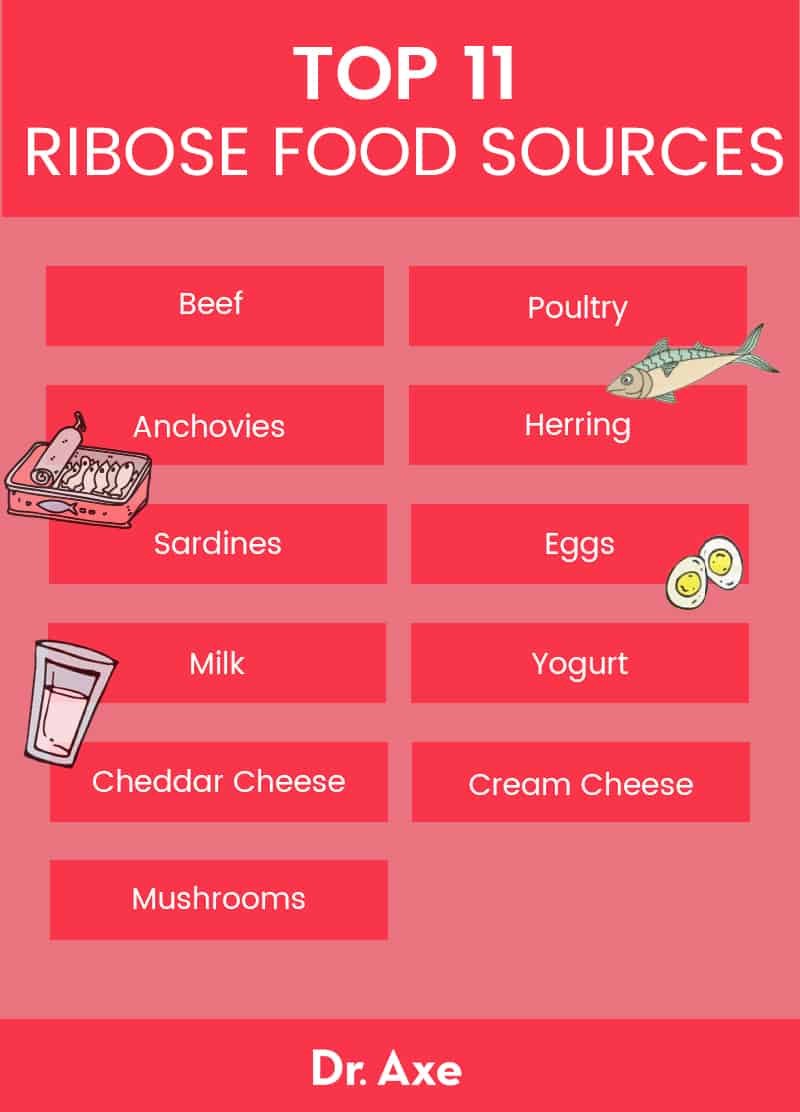Ribose: Energy-Boosting Heart Supporter or Sugar Trap?
December 26, 2018

What is D-ribose? Ribose, also known as D-ribose, is naturally created by our bodies. Why is it so important? Because it actually helps provide our cells with sufficient energy. This is key to all of our many cells maintaining both their integrity and their function. In fact, scientific studies show that D-ribose may help a number of serious health concerns, including heart diseases, fibromyalgia symptoms and chronic fatigue syndrome.
What is D-ribose found in? It can be obtained from both animal and plant sources. It’s also available in supplement form. Let’s take a look at how you can consume more of this important compound on a daily basis and also if a supplement may be a natural and therapeutic option for your particular health concerns.
What Is Ribose?
D-ribose is commonly found in nature and the human body. There’s also a synthetic version known as L-ribose, which is cannot be found in natural environments. What does D-ribose structure look like from a chemical perspective? The chemical formula is C5H10O5. That means it contains five carbon atoms, 1o hydrogen atoms and five oxygen atoms.
Is D-ribose a sugar? A standard ribose definition is a type of simple sugar or carbohydrate that our bodies produce and then use to create adenosine triphosphate (ATP). ATP is the fuel burned by the mitochondria found in our cells. As you may already know, ATP energy production is absolutely key to health since ATP is the body’s most basic form of energy. Even though D-ribose is a simple sugar, it’s important to note that it is not known for raising blood sugar. In fact, takers of the supplement are often warned that it can lower blood sugar.
Some of the higher producers of this natural sugar include the liver, adrenals and fat tissue, but the heart, brain, muscles and nerve tissues also make it. It’s also a component of adenosine. Adenosine is a natural chemical found inside all human cells and is available in supplement form as well.
5 D-Ribose Benefits and Uses
- Supports Heart Health
- Enhances Exercise
- Helps Treat Fibromyalgia and Chronic Fatigue Syndrome
- May Help Manage Myoadenylate Deaminase Deficiency Symptoms
- Boosts Skin Health
1. Supports Heart Health
Heart disease continues to be a leading cause of death worldwide. What does D-ribose do for the heart? There is evidence that it helps patients with heart problems, including ischemic cardiovascular disease as well as congestive heart failure. A common aspect of cardiovascular diseases is myocardial ischemia. This occurs when blood flow to the heart decreases and prevents the heart from receiving enough oxygen. In general, myocardial ischemia lowers cellular energy levels. Research using both human and animal subjects demonstrate that D-ribose can help replenish deficient cellular energy levels following myocardial ischemia and also boost heart function.
A scientific review published in 2018 highlights pre-clinical and pilot clinical studies showing this sugar’s ability to enhance the recovery of ATP levels and also aid in improving left ventricular diastolic dysfunction following ischemia. Overall, D-ribose appears to improve myocardial energy levels and function for people with ischemic cardiovascular diseases.
2. Enhances Exercise
D-ribose is naturally found in our cells, and it is essential to energy production. A double-blind, crossover, clinical study published in 2017 in the Journal of the International Society of Sports Nutrition looked at the effects of 10 grams per day of D-ribose versus the same dosage of dextrose (glucose) on 26 healthy subjects. While taking the sugars, the subjects participated in 60 minutes of high-intensity interval exercise in separate daily sessions.
The researchers found that mean and peak power output increased significantly from day one to day three for the D-ribose groupcompared to the dextrose group. The D-ribose group also had a significantly lower rate of perceived exertion than the dextrose takers.
3. Helps Treat Fibromyalgia and Chronic Fatigue Syndrome
Does D-ribose help fibromyalgia? Research shows that it may be a very helpful component of natural fibromyalgia treatment. Scientific studies show that taking a supplement of this natural sugar may help to improve sleep, improve energy levels, improve your sense of well-being and decrease pain for those diagnosed with fibromyalgia.
A study of the effects of D-ribose on 41 people with chronic fatigue syndromeand/or fibromyalgia was published in the Journal of Alternative and Complementary Medicine. Participants were given five grams of the sugar daily, and 66 percent of patients experienced significant improvement. Overall, the pilot study found that D-ribose significantly reduced clinical symptoms for those with fibromyalgia and chronic fatigue syndrome.
4. May Help Manage Myoadenylate Deaminase Deficiency Symptoms
Myoadenylate deaminase deficiency (MAD) is a metabolic muscle disease that interferes with the processing of ATP by muscle cells. Symptoms of this condition can include cramps, muscle pain and exercise intolerance. However, having no symptoms is also possible. For people struggling with MAD, there is some evidence that taking D-ribose by mouth or receiving it intravenously from a health care professional may effectively prevent symptoms, such as cramping, pain and stiffness after exercise.
5. Boosts Skin Health
This naturally occurring sugar may also offer impressive benefits for skin health, especially when it comes to anti-aging efforts. As we age, our cells naturally produce less ATP. The good news is that this naturally occurring sugar boosts ATP regeneration.
One study tested a topical D-ribose-based (0.5 percent) facial lotion on 20 adult women with decreased skin tone and wrinkles. The female subjects were objectively and subjectively evaluated at 14 and 28 days while applying the lotion on a daily basis. What did they find? After 14 days, there was a significant reduction of 12.2 percent in total wrinkle surface area and a 9.1 percent reduction in total wrinkle length. After 28 days, total wrinkle surface area remained at 12.2 percent while average wrinkle length reduced even more for a total of 17.6 percent. Overall, 67 percent of the subjects thought their skin looked more glowing and radiant after the treatment.
These results show that this natural carbohydrate is a potential anti-aging supplement for skin health.

D-Ribose Foods and Sources
What foods are high in ribose? It can be found in the following food sources:
- Grass-fed beef
- Poultry
- Anchovies
- Herring
- Sardines
- Eggs
- Milk
- Yogurt
- Cheddar cheese
- Cream cheese
- Mushrooms
It can be difficult to get enough from dietary sources, however. That’s why many people choose to take a supplement.
D-Ribose Supplement and Dosage Recommendations
This natural sugar is available in health stores and online in supplement form as a powder, chewable tablet or capsule. You can take the powder in water or add it to other beverages, like smoothies, or mix it into kefir or yogurt. Powder form is definitely a popular way to take it, but reading D-ribose reviews may help you to determine which supplement is best for your you. It is also a component of multi-ingredient supplements for energy.
How much D-ribose should you take in supplement form? Most makers of these supplements recommend doses between one to 10 grams per day. When should I take D-ribose? If you’re taking it for an exercise boost, a common recommendation is to take it with morning and evening meals or right before and right after physical activity.
To improve the ability of people with coronary artery disease to exercise, the following D-ribose dosage by mouth has been studied: 15 grams four times daily taken one hour prior to exercise until the end of the exercise session. In other words, take three grams every 10 minutes during exercises. This has been used to decrease muscle stiffness and cramps caused by exercising.
Some other recommended dosing starting points include:
- 5 grams daily for cardiovascular prevention, for athletes on maintenance and for healthy people doing strenuous activity
- 10–15 grams daily for most patients with heart failure, other forms of ischemic cardiovascular disease or peripheral vascular disease; for individuals recovering from heart surgery or heart attack; for treatment of stable angina; and for athletes working out in chronic bouts of high-intensity exercise
- 15–30 grams daily for patients with advanced heart failure, dilated cardiomyopathy or frequent angina; for individuals awaiting heart transplants; and for people with fibromyalgia or neuromuscular disease
Talk to your health care provider if you are unsure what dosage is right for you.
How to Get More Ribose + Recipes
If you’re looking to incorporate more foods rich in D-ribose into your daily diet, here are some healthy and delicious recipes to try out today:
- Moo Shu Chicken Lettuce Wraps
- Crustless Spinach Quiche Recipe
- Gluten-Free Cauliflower Mac and Cheese Recipe
- Slow Cooker Salisbury Steak Recipe
Ribose vs. Deoxyribose
Ribose and deoxyribose are both five-carbon sugars that each contain 10 hydrogen atoms. The molecular formula of ribose is C5H10O5, and the molecular formula of deoxyribose (2-deoxyribose) is C5H10O4. Does DNA contain ribose? It is a component of RNA while deoxyribose is part of DNA. RNA stands for ribonucleic acid, and it is a complex compound that plays a vital role in cellular production of proteins. It also replaces DNA (deoxyribonucleic acid) as a carrier of genetic codes in some viruses.
The biggest difference between deoxyribose vs. ribose is one oxygen atom. The ribose found in RNA is considered a “normal” sugar with one oxygen atom that attaches to each carbon atom. Meanwhile, the deoxyribose in DNA is a modified sugar and lacks one oxygen atom. This single oxygen atom difference between the two sugars is key to distinguishing the two sugars within organisms.
History and Interesting Facts
- In 1909, Phoebus Levene successfully isolated the D-ribose from ribonucleic acid. In 1929, he went on to discover 2-deoxyribose.
- D-ribose is a sugar the human body uses to manufacture adenosine triphosphate (ATP), which is the energy that fuels our cells and therefore our bodies.
- It can be found in foods but not in very high or significant amounts. That is why some people choose to supplement.
Side Effects, Interactions and Precautions
For most people, D-ribose is typically safe by mouth on a short-term basis or when a health care provider administers it intravenously (by IV).
Are there any D-ribose dangers? Some potential side effects include upset stomach, diarrhea, nausea and headache. Does ribose raise blood sugar? Actually, it may decrease blood sugar so, typically, people with hypoglycemia or diabetes should not take these type of supplements. In addition, you should not take it two weeks prior to any surgery due to its possible blood sugar effects.
Drugs known to moderately interact with this naturally occurring sugar include insulin and other antidiabetes drugs. Other things that may have more minor interactions include alcohol, aspirin, choline magnesium trisalicylate (Trilisate), propranolol (Inderal) and salsalate (Disalcid).
Check with your doctor before taking these supplements if you are pregnant, nursing, have an ongoing medical condition or currently take any medication.
Final Thoughts
- What is ribose sugar? Also known as D-ribose, this simple sugar is naturally in plants, animals and humans.
- It’s key to the body’s ATP molecule production and hence energy levels.
- The most notable function of this compound is that it provides a key energy source. This is why many people take ribose supplements to boost exercise performance as well as recovery.
- Scientific studies show that it can help a number of health concerns, including heart diseases, fibromyalgia symptoms and chronic fatigue syndrome.
- Research shows that it can boost skin health, especially when it comes to visible signs of aging like wrinkles.
- You can obtain it through your diet by eating foods like grass-fed beef, organic chicken, sardines, eggs and yogurt.
- You can also take it as supplement, including in powder form, which you can add to beverages, yogurt, etc.

No comments:
Post a Comment